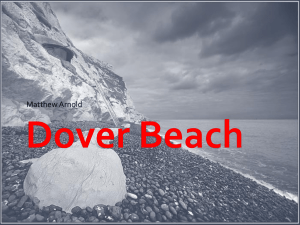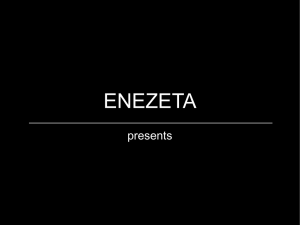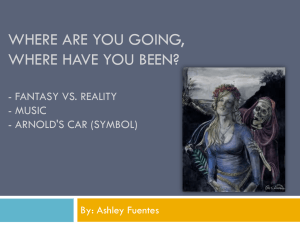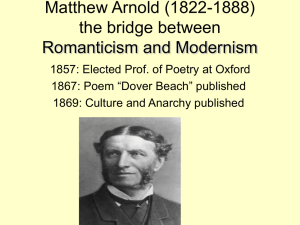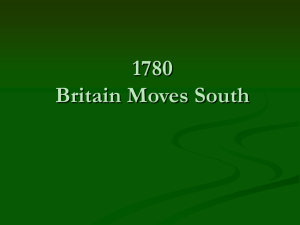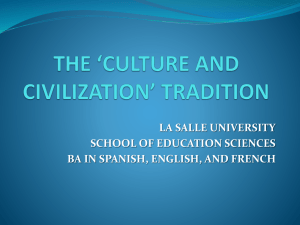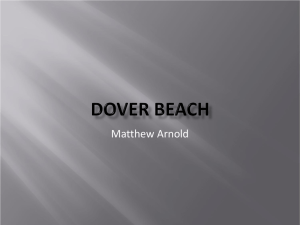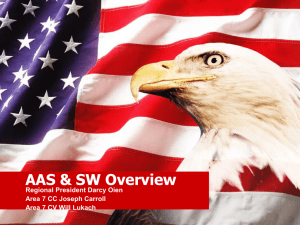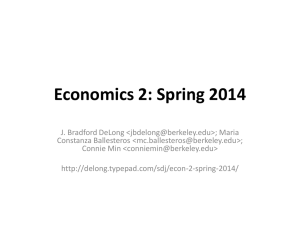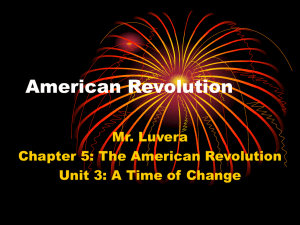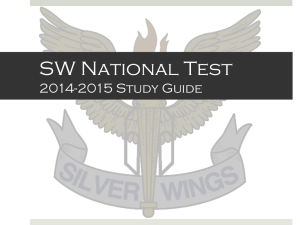Dover Beach PowerPoint
advertisement
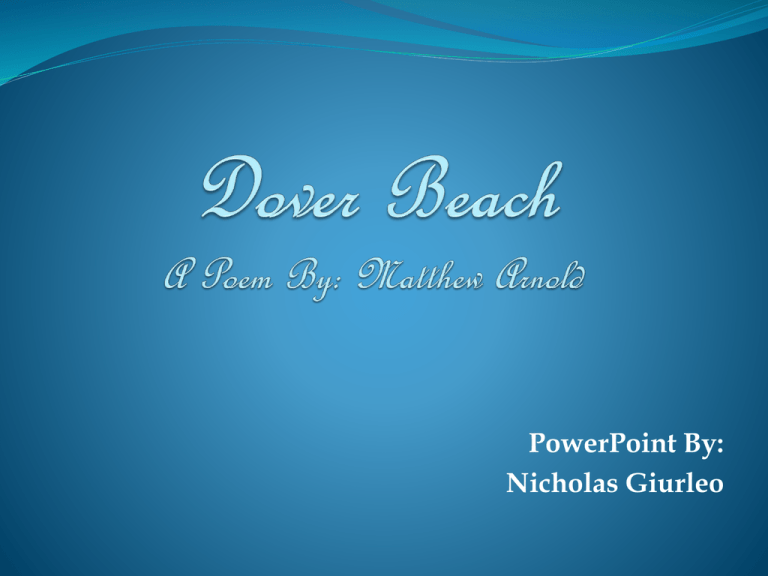
PowerPoint By: Nicholas Giurleo Poet Biography: Matthew Arnold Date and Place of Birth: December 24, 1822 in Laleham, England Eldest son of Thomas Arnold and Mary (Penrose) Arnold; his father was a historian and the Headmaster of Rugby School located in Rugby, England Received an education at Winchester College , Rugby School, Balliol College and Oxford University 1828: his family moved from Laleham to Rugby when Thomas Arnold received a job as headmaster at Rugby 1831: he was sent back to Laleham to be under the care of his uncle John Buckland at his preparatory school; he returned home and was tutored along with his younger brother Tom Poet Biography: Matthew Arnold (Cont.) 1838-1842:Matthew and his brother produced a magazine twice yearly called the “Fox How Magazine”; poetry from Mathew was featured frequently Also at this time Matthew received his secondary education at Winchester, Rugby, and Balliol College; he received many awards for poems he wrote such as “Alaric at Rome” and “Cromwell” 1842: his father unexpectedly died 1843:graduated from Oxford with 2nd Class Honors in “Greats” (a completion of the classics course) The years after his graduation he spent much of his time teaching at Rugby and traveling through Europe (i.e. Wales, Ireland, and France) after he received a fellowship (a funding for additional educational endeavors) by Oriel College Poet Biography: Matthew Arnold (Cont.) 1847: granted the position of secretary by a lord named Lansdowne who personally knew Arnold’s father; Lansdowne was a very generous employer to Arnold and gave him many holidays which Arnold spent traveling the European continent 1849: anonymously published his first poetry book, The Strayed Reveller and Other Poems 1851: with the recommendation of Lansdowne, he was promoted to inspector of the schools of London by the crown (Queen Victoria); he remained in this position for 35 years Shortly after securing this financially beneficial position he married Fanny Lucy (Flu) Wightman; she was the daughter of a judge; she bore Arnold six children; three died in early childhood Poet Biography: Matthew Arnold (Cont.) During the later part of his life Arnold began to devote more attention to social and theological subjects; such works included his Last Essays on Church and Religion and the Church of England; Arnold was a devout Christian who concluded in his writings that Christianity would survive because the teachings of Christ addressed issues central to the moral existence of mankind 1883: receives a substantial pension from Prime Minister Gladstone After receiving this pension he took two lecture tours through the United States; these lectures were published later as his Discourses in America 1888: he died suddenly while walking with his wife to catch a tram (a trolley) in Liverpool to meet his daughter who was arriving by boat from the United States Inspiration for Writing Dover Beach Following his honeymoon with his wife, Arnold and his wife visited Dover, Kent, England, and he had the inspiration to write this poem after spending time on the coastal beach with his wife through the admiring of the view of the Strait of Dover… Some events Arnold lived through (roughly 1822-88): 1819—Queen Victoria is born 1829—Catholic Emancipation, ends most restrictions on Catholic civil rights, property ownership, & public service. 1834—Slavery banned in British colonies. 1844—Irish potato famine begins. 1848—Marx and Engels, Communist Manifesto. 1851—First telegraph cable laid across the English Channel 1853–56—Crimean War 1858—Government of India transferred to the Crown. 1859—Darwin’s Origin of the Species. 1868—Disraeli becomes Prime Minister 1879—Edison invents the electric light bulb 1901—Death of Queen Victoria at age 82 Speaker A male individual on a beach near Dover, England (almost certainly Matthew Arnold) Audience A female individual on the beach listening to the speaker; the speaker loves this individual (almost certainly Arnold’s wife Fanny) Purpose To emphasize the message that challenges to the validity of longstanding theological and moral beliefs has harmed society’s faith in religion Poem Type This poem is free verse because it has no defined structure (i.e. no consistent rhyme scheme) and the ideas of the poem are broken up into sentences. Literal Meaning First Sentence: (lines 1) The sea is calm to-night. 1. Tonight the sea is calm. Second Sentence: (lines 2-5) The tide is full, the moon lies fair Upon the straits; -on the French coast the light Gleams and is gone; the cliffs of England stand, Glimmering and vast, out in the tranquil bay. 2. It is full tide, and the water reflects the image of the moon. The enormous cliffs of England, like the French coast glimmer brightly. Third Sentence: (line 6) Come to the window, sweet is the night-air! 3. Come to the window. The night air is sweet. Fourth Sentence: (lines 7-14) Only, from the long line of spray Where the sea meets the moon-blanch’d land, Listen! you hear the grating roar Of pebbles which the waves draw back, and fling, At their return, up the high strand, Begin, and cease, and then again begin, With tremulous cadence slow, and bring The eternal note of sadness in. 4. Where the ocean meets the land whitened by the light of the moon you can hear the roar of pebbles which the waves take into sea and throw back to the land. Again and again this happens in almost a rhythmic way. It is quite saddening. Literal Meaning (cont.) Fifth Sentence: (lines 15-20) Sophocles long ago Heard it on the Aegean, and it brought Into his mind the turbid ebb and flow Of human misery; we Find also in the sound a thought, Hearing it by this distant northern sea. 5. I hear now the sound of sadness that the ancient Greek dramatist Sophocles once heard on the Aegean Sea. Like Sophocles I too hear a thought from the sea that greatly disturbs me. Sixth Sentence: (lines 20-22) The Sea of Faith Was once, too, at the full, and round earth's shore Lay like the folds of a bright girdle furl’d. 6. Religion (Christianity) was once wrapped around the world much like how a girdle surrounds a person’s waste. Literal Meaning (cont.) Seventh Sentence: (lines 23-27) But now I only hear Its melancholy, long, withdrawing roar, Retreating, to the breath Of the night-wind, down the vast edges drear And naked shingles of the world. 7. Now I only hear the sad withdrawing roar of the night wind that blows down the vast and dull gloomy edges of the world 8. But love, let us be honest to each Eighth Sentence: (lines 27-34) other. The world appears to be a land Ah, love, let us be true of beautiful and new dreams, To one another! for the world, which seems To lie before us like a land of dreams, however in reality it is not. There is So various, so beautiful, so new, no love, no peace, no joy, no light, Hath really neither joy, nor love, nor light, and no compassion. Here we are on a Nor certitude, nor peace, nor help for pain; dark beach confused and lost And we are here as on a darkling plain Swept with confused alarms of struggle and flight, because around us the battle Where ignorant armies clash by night. between the ignorant forces of religion and science fights on. Figurative Language Simile Example: (lines 20-22) …The Sea of Faith Was once, too, at the full, and round earth's shore Lay like the folds of a bright girdle furl’d. Sea of Faith (symbolic for religion) girdle = surrounds/encircles Emphasis on symbolizing religion Metaphor Example: (line 20) …The Sea of Faith Faith Sea = flood/inundate Emphasis on symbolizing religion Symbol Example: (line 1) The Sea = religion (Christianity) Example: (line 8) Land = science The poem is an allegory for the battle at the time between religious conformity of the past and scientific and rationalist thought promoted by industrialization and the Victorian Era Hyperbole Example: (line 14) The eternal note of sadness Calling sadness an eternal note is an extreme exaggeration Emphasizes the speaker’s sadness for observing what he believes is a symbolic representation of the battle between science and religion Allusion Example: (lines 15-18) Sophocles long ago Heard it on the Aegean, and it brought Into his mind the turbid ebb and flow Of human misery These lines allude to a passage in the ancient Greek play Antigone, by Sophocles. The eternal note of sadness also is a reference to a line from this play. Arnold is possibly referencing that Sophocles also experienced a sensation of revelation similar to the one Arnold experienced on the beach of Dover Metonymy Example: (line 15) Sophocles = tragedy Sophocles was essentially the inventor of the play type of tragedy because he was one of the first documented humans to ever write a piece in this type Personification Example: (lines 8-9) …[the] roar Of pebbles Pebbles cannot roar; roaring is a human trait Sensory detail that can also be interpreted as metaphoric for science making increasing noise and becoming more apparent to religious conformists throughout the changing world Synecdoche, Euphemism, and Apostrophe Not present in this poem Sound Devices Assonance Example: (line 2) The tide is full, the moon lies fair Sensory detail that metaphorically represents the security of religion prior to the emergence of new scientific and rational thought Consonance Example: (line 33) Swept with confused alarms of struggle and flight Adds to the sudden change in intensity at the end of the poem which metaphorically represents the panic organized religion was facing by the suddenly emergence of developing scientific thought Dissonance Examples: (line 34) Ignorant clash (hard “g” sound) (hard “k” sound) Adds to the sudden change in intensity at the end of the poem which metaphorically represents the panic organized religion was facing by the suddenly emergence of new scientific developments Alliteration Example: (lines 1-2) The sea is calm to-night. The tide is full, the moon lies fair Sensory detail that adds to the metaphorical representation of the security of religion before the emergence of new rational scientific thought Repetition Example: (lines 1-2, 4) The sea is calm to-night. The tide is full, the moon lies fair Upon the straits; -on the French coast the light Gleams and is gone… The use of this repeated verb helps to illustrate the scenery; more sensory detail to add to the metaphorical representation of the security of religion before the emergence of new rational scientific thought Internal Rhyme Example: (line 12) Begin, and cease, and then again begin, Begin, again, and begin rhyme and are all located in one single line of the poem Emphasizes metaphorically the back and forth struggle between religion and science Onomatopoeia Example: (line 9) roar The word roar sounds like what it actually represents Personifies the pebbles from line 10 Rhyme Scheme Not present in this poem Fin. Thanks for Thanks for Watching! Watching! Next Slide is Bibliography Bibliography
